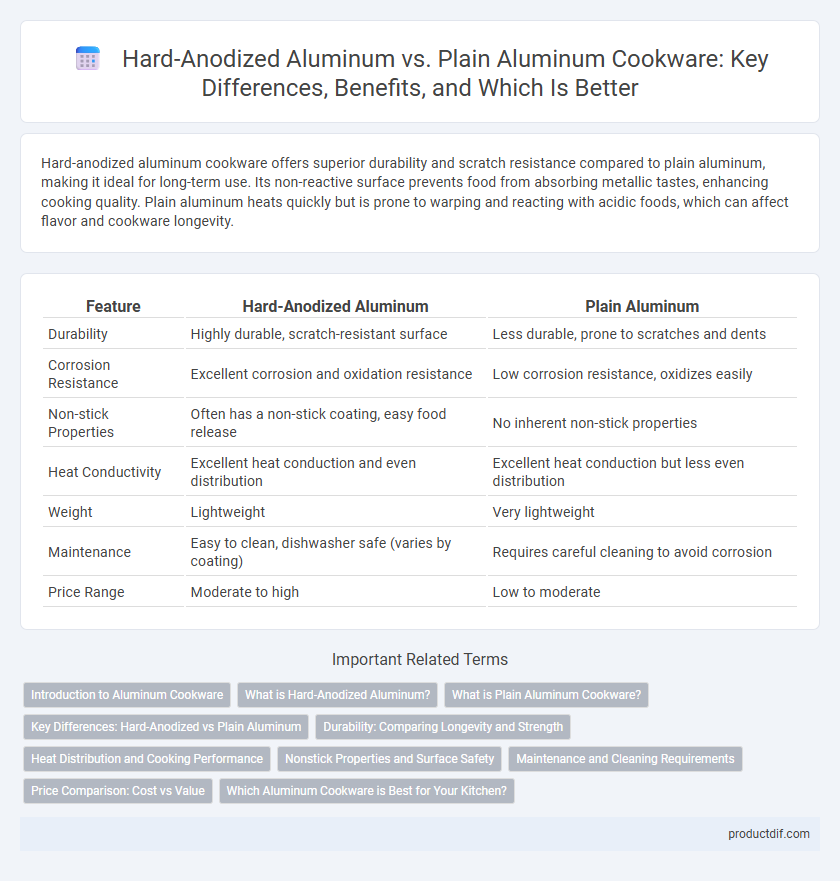Hard-anodized aluminum cookware offers superior durability and scratch resistance compared to plain aluminum, making it ideal for long-term use. Its non-reactive surface prevents food from absorbing metallic tastes, enhancing cooking quality. Plain aluminum heats quickly but is prone to warping and reacting with acidic foods, which can affect flavor and cookware longevity.
Table of Comparison
| Feature | Hard-Anodized Aluminum | Plain Aluminum |
|---|---|---|
| Durability | Highly durable, scratch-resistant surface | Less durable, prone to scratches and dents |
| Corrosion Resistance | Excellent corrosion and oxidation resistance | Low corrosion resistance, oxidizes easily |
| Non-stick Properties | Often has a non-stick coating, easy food release | No inherent non-stick properties |
| Heat Conductivity | Excellent heat conduction and even distribution | Excellent heat conduction but less even distribution |
| Weight | Lightweight | Very lightweight |
| Maintenance | Easy to clean, dishwasher safe (varies by coating) | Requires careful cleaning to avoid corrosion |
| Price Range | Moderate to high | Low to moderate |
Introduction to Aluminum Cookware
Hard-anodized aluminum cookware features a durable, non-reactive surface created through an electrochemical process, enhancing scratch resistance and heat distribution compared to plain aluminum. Plain aluminum cookware offers excellent thermal conductivity and lightweight properties but is prone to scratching, warping, and reacting with acidic foods. Choosing hard-anodized aluminum provides improved longevity and performance, making it a preferred option for both professional chefs and home cooks seeking reliable, high-quality cookware.
What is Hard-Anodized Aluminum?
Hard-anodized aluminum is a type of aluminum cookware treated through an electrochemical process that thickens the natural oxide layer, making it more durable and resistant to corrosion and scratches. This enhanced surface provides superior non-stick properties compared to plain aluminum, which is softer and prone to warping or reacting with acidic foods. As a result, hard-anodized aluminum cookware offers better heat distribution, increased longevity, and easier maintenance for everyday cooking.
What is Plain Aluminum Cookware?
Plain aluminum cookware is made from a single sheet of aluminum, known for its excellent heat conductivity and lightweight properties. It heats quickly and distributes heat evenly but is prone to scratching, warping, and reacting with acidic foods, which can affect the taste and appearance of dishes. Unlike hard-anodized aluminum, plain aluminum lacks the durable, non-reactive surface that enhances longevity and resistance to corrosion.
Key Differences: Hard-Anodized vs Plain Aluminum
Hard-anodized aluminum cookware features a chemically treated surface that is significantly harder and more resistant to scratches, corrosion, and wear compared to plain aluminum. This treatment creates a non-reactive, durable layer that enhances heat distribution and prevents food from reacting with the metal, unlike plain aluminum which is softer and prone to bending and scratching. Hard-anodized aluminum typically offers superior non-stick properties and longer lifespan, making it a preferred choice for heavy-duty cooking applications.
Durability: Comparing Longevity and Strength
Hard-anodized aluminum cookware offers significantly greater durability than plain aluminum due to its electrochemically treated surface, which enhances resistance to scratches, corrosion, and warping. This protective layer increases the cookware's longevity, maintaining performance and appearance over years of regular use. Plain aluminum, while lightweight and conductive, is softer and prone to dents, scratches, and discoloration, reducing its overall lifespan compared to hard-anodized alternatives.
Heat Distribution and Cooking Performance
Hard-anodized aluminum cookware offers superior heat distribution compared to plain aluminum due to its dense, non-porous surface that resists warping and ensures even cooking temperatures. This enhanced heat conduction results in consistent cooking performance, preventing hot spots and allowing precise temperature control. Plain aluminum, while lightweight and conductive, often heats unevenly and is prone to scratching and discoloration, which can negatively impact cooking results over time.
Nonstick Properties and Surface Safety
Hard-anodized aluminum cookware features a dense, non-reactive surface that enhances nonstick properties and resists scratches, promoting safer cooking without aluminum leaching. Plain aluminum, while lightweight and conductive, lacks a durable nonstick coating and can react with acidic foods, potentially compromising surface safety and flavor. Choosing hard-anodized aluminum ensures better food release and long-lasting surface integrity for healthier cooking experiences.
Maintenance and Cleaning Requirements
Hard-anodized aluminum cookware features a dense, non-porous surface that resists scratches and corrosion, making it easier to clean and maintain without the risk of aluminum leaching. Plain aluminum cookware, however, requires more frequent seasoning and careful cleaning to prevent oxidation and damage, as it is softer and more prone to wear over time. Regular hand washing with mild detergent is recommended for both types, but hard-anodized surfaces tolerate scrubbing better and retain their finish longer under routine maintenance.
Price Comparison: Cost vs Value
Hard-anodized aluminum cookware typically costs 30-50% more than plain aluminum due to its enhanced durability and non-reactive surface. While plain aluminum is budget-friendly, it often warps or corrodes over time, leading to more frequent replacements. Investing in hard-anodized cookware offers better long-term value by combining rust resistance, superior heat distribution, and extended lifespan.
Which Aluminum Cookware is Best for Your Kitchen?
Hard-anodized aluminum cookware offers superior durability and non-reactive surfaces compared to plain aluminum, making it resistant to scratching and corrosion while ensuring even heat distribution. Plain aluminum cookware is lightweight and affordable but prone to warping, scratching, and reacting with acidic foods, which can affect flavor and safety. For long-term kitchen use, hard-anodized aluminum is the best choice due to its strength, non-toxic coating, and excellent cooking performance.
Hard-Anodized Aluminum vs Plain Aluminum Infographic

 productdif.com
productdif.com